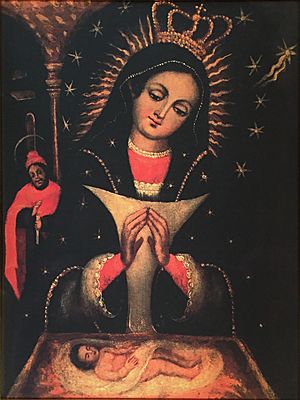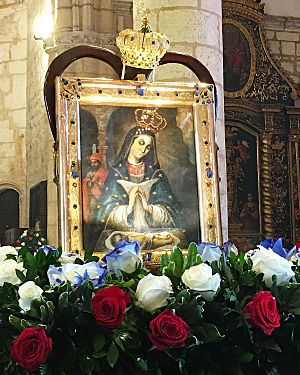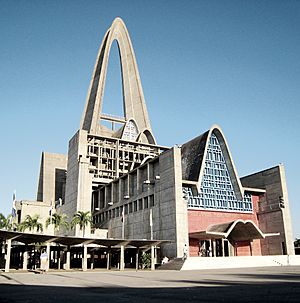Our Lady of Altagracia facts for kids
Quick facts for kids La Virgen de la Altagracia |
|
|---|---|

Spritual mother of the Dominican Republic and People of the Dominican Republic
|
|
| Protective and Spiritual Mother of the Dominican People | |
| Venerated in | Roman Catholic Church; introduced to Hispaniola in 1502 |
| Major shrine | Basílica Catedral Nuestra Señora de la Altagracia |
| Feast | January 21 |
| Attributes | The Star of Bethlehem and 12 stars that represent the tribes of Israel and a silver crown |
| Patronage | The Dominican Republic and in any difficult situation |
Our Lady of Altagracia is a special figure in the Catholic Church. She is seen as the "protective and spiritual mother of the Dominican people." Her feast day is January 21. This is a holiday in the Dominican Republic. Many people travel from all over the country to the Basílica Catedral Nuestra Señora de la Altagracia in La Altagracia Province. People also honor her in places outside the Dominican Republic, like New York City. Her feast day there starts Dominican Heritage Month.
Contents
How the Virgin of Altagracia Arrived
Some historians say that the image of Our Lady of Altagracia came to the island of Hispaniola in 1502. It was taken to a church in Salvaleón de Higüey. This happened because two brothers, Alonso and Antonio Trejo, arrived in Higüey. They came from Plasencia, a town in Spain.
There is a story from their home region of Extremadura. It says that the Virgin Mary appeared to a shepherd girl on a rock. The girl took a small image of Mary to her home. But the next morning, the image was gone. It reappeared on the same rock. This happened many times. Finally, people dug under the rock and found the image. Today, it is honored in a small church built for her.
Another story from 1650, written by Canon Luis Gerónimo de Alcocer, also talks about the Trejo brothers bringing the image to the island. He said they were among the first Christian settlers.
Why January 21 is Her Feast Day
The official festival for Our Lady of Altagracia is on January 21. This date is important because of a battle that happened in 1691. It was called the Battle of Sabana Real. The Spanish army, led by Antonio Miniel, fought and defeated the French army.
Some people say the Spanish soldiers asked the Virgin of Altagracia for help to win the battle. After their victory, they held a big religious celebration on January 21 to honor her. Even though some believe her feast should be on August 15 (when the image was brought to the island), January 21 became the special day.
Another story says the Virgin first appeared to a Spanish farmer in Extremadura. He was walking in the forest when she appeared in a tree. This is why she is called "Lady of Altagracia," meaning "Lady of High Grace." When Christopher Columbus made his last trips, some Spaniards brought her image to the Higüey region of the island. From then on, people and the Catholic Church began to honor her as a protector of the Dominican people. Many miracles were said to happen, and so the tradition of visiting her church in Higüey every January 21 began.
Official Recognition of the Feast Day
The Catholic Church officially made January 21 a religious holiday. This happened in 1692, when Archbishop Isidoro Rodríguez Lorenzo approved the date. Later, Monsignor Arturo de Meriño, the Archbishop of Santo Domingo, asked the Holy See (the Pope's office) to make January 21 a mandatory holiday. He explained that August 15 was already a holiday for the Assumption of Mary.
In the Dominican Republic, January 21 was officially declared a national and religious holiday by law. This was done during the government of Horacio Vásquez, who was a strong believer in the Virgin.
Special Honors for the Virgin
People have been making pilgrimages and celebrating Our Lady of Altagracia since colonial times. In the 20th century, she was crowned twice. The first time was on August 15, 1922, at the Puerta del Conde. Pope Pius XI sent a representative for this event. The image was decorated with gold and jewels, and a special crown was made.
In 1924, the government made January 21 a national holiday. Then, in 1927, Pope Pius XI declared it a Church holiday.
Pope John Paul II also honored her. On his first visit to the Dominican Republic in 1979, he blessed her church (now the Basilica of Higüey). On his second visit in 1992, he personally crowned the image with a silver crown. Most recently, in 2022, Pope Francis sent a golden rose to honor her during the celebrations of her 100th anniversary of coronation.
The Image of the Virgin of Altagracia
The painting of Our Lady of Altagracia shows the birth of Jesus in a manger in Bethlehem. It highlights Mary as a mother. In the painting, you can see the Star of Bethlehem. It has eight points and represents heaven. Two rays from the star point towards the manger where God is blessing his son, Jesus.
Above the Virgin, there are twelve stars. These stars represent the tribes of Israel and the Apostles in the New Testament. Mary has a glow around her, like in the Bible (Revelation 12:1).
La Altagracia wears a crown because she is the Queen of Heaven. She also wears a veil because she is married to Joseph. Her clothes are red, white, and blue. Red shows she is a beautiful human being. White means she was born without sin. The blue cloak shows that "the power of the Most High will come upon you" and that she is the queen of heaven.
In front of Mary, the Christ Child is sleeping on straw. Behind him is Saint Joseph, wearing a red cape and holding a candle. Mary is shown praying, with her hands together. A white, triangle-shaped light is on her chest. This light rises from the manger to her shoulders. It shows that Jesus was born without sin.
Mary's face looks calm and peaceful. Her eyes are looking down, showing meditation. Her head is covered with a dark blue veil and a pearl crown. The crown shows she is a queen because she is the mother of the King. Around her head are twelve stars, representing the Catholic Church and its twelve apostles. Behind her, a large star shines. This is the same star that guided the Biblical Magi to find the Savior. Her cloak has sixteen small stars. Behind her is a column, which means the birth cave is like a temple because baby Jesus, who is God, lives there.
Devotion to Altagracia

The devotion to Our Lady of Altagracia started in Higüey. Over the years, it grew and became a big part of the Dominican identity. It is now the main pilgrimage for many people in the country.
According to historian Alejandro Paulino Ramos, people started honoring Altagracia in the mid-1500s. This happened in both Santo Domingo and Higüey. He notes that August 15 was originally the main day of devotion. This was because the image was brought to the island on that date.
Bishop Ramón Benito believes the story of the Trejo brothers is the most likely. They came from Extremadura, where Altagracia was already popular. When they moved to Higüey, they brought their devotion and the image with them.
Popular Stories and Legends
There are many stories about how the Virgin of Altagracia came to the Dominican Republic. One well-known story is told by Monsignor Juan Pepén in his book "Dónde floreció el naranjo" (Where the Orange Tree Bloomed).
It tells of a Spanish farmer who lived in Higüey a long time ago. He often traveled to Santo Domingo to sell cattle. One day, his youngest daughter asked him to bring her an image of the Virgin of Altagracia. She had seen the Virgin in a dream. This was strange because no one had heard of such a Virgin. The farmer looked everywhere in Santo Domingo but could not find the image.
On his way home, he stayed overnight at a friend's house. He told his friend about his daughter's request and how sad he was not to find the image. That same night, an old man came to stay at the house. When he heard the farmer's story, the old man said he had the image with him. He took out a painting of Altagracia from his bag. It was a beautiful image of Mary adoring a newborn baby in a cradle. The old man gave the painting to the farmer. The next morning, the old man was gone and was never seen again.
When the farmer arrived home, he gave the painting to his youngest daughter. On January 21, at the foot of an orange tree (which is still there today), the girl showed the image to everyone. From that day on, people began to honor the Virgin of Altagracia. The girl was later buried at the foot of that orange tree. For over a month after, the painting would appear in the tree under which its owner could be found.
Places Honoring Her
Many places around the world honor Our Lady of Altagracia as their patron saint:
 Argentina In Alta Gracia, Córdoba Province, Argentina, the city is named after her.
Argentina In Alta Gracia, Córdoba Province, Argentina, the city is named after her. Spain She is the patron saint of Garrovillas de Alconétar, Province of Cáceres and Siruela, Province of Badajoz.
Spain She is the patron saint of Garrovillas de Alconétar, Province of Cáceres and Siruela, Province of Badajoz. Panama She is the patron saint of Jobo Dulce, Los Santos Province, Panamá.
Panama She is the patron saint of Jobo Dulce, Los Santos Province, Panamá. Dominican Republic She is the patron saint of La Altagracia Province, Dominican Republic.
Dominican Republic She is the patron saint of La Altagracia Province, Dominican Republic. Dominican Republic She is the patron saint of the parish in Loma de Cabrera, Dominican Republic.
Dominican Republic She is the patron saint of the parish in Loma de Cabrera, Dominican Republic. Dominican Republic She is the patron saint of Castañuelas, Montecristi, Dominican Republic.
Dominican Republic She is the patron saint of Castañuelas, Montecristi, Dominican Republic. Dominican Republic She is the patron saint of Villa Altagracia, Dominican Republic.
Dominican Republic She is the patron saint of Villa Altagracia, Dominican Republic. Venezuela Altagracia de Orituco: This city in Venezuela has celebrated her since 1705.
Venezuela Altagracia de Orituco: This city in Venezuela has celebrated her since 1705. Venezuela Los Puertos de Altagracia: This city is named after the Virgin.
Venezuela Los Puertos de Altagracia: This city is named after the Virgin. Venezuela She is the patron saint of Curiepe, State of Miranda.
Venezuela She is the patron saint of Curiepe, State of Miranda. Venezuela She is the patron saint of Quíbor and Jimenez Municipality in Lara (state). A procession there uses a canvas from 1605.
Venezuela She is the patron saint of Quíbor and Jimenez Municipality in Lara (state). A procession there uses a canvas from 1605. Peru She is the patron saint of Huamachuco, in the province of Sánchez Carrión.
Peru She is the patron saint of Huamachuco, in the province of Sánchez Carrión. Peru She is the patron saint of Ayaviri, Melgar, in the province of Melgar.
Peru She is the patron saint of Ayaviri, Melgar, in the province of Melgar. Mexico She is the patron saint of Altagracia, Zapopan, México.
Mexico She is the patron saint of Altagracia, Zapopan, México.
Images for kids
Online Resources
- Corazones.org
- Vicente Noble.org
- Rincón Dominicano
- Usuarios.lycos.es
- Alkonetara Garrovillas
- Dominikano.com
- Mimejormaesro.blogspot.com
See also
 In Spanish: Nuestra Señora de la Altagracia para niños
In Spanish: Nuestra Señora de la Altagracia para niños



